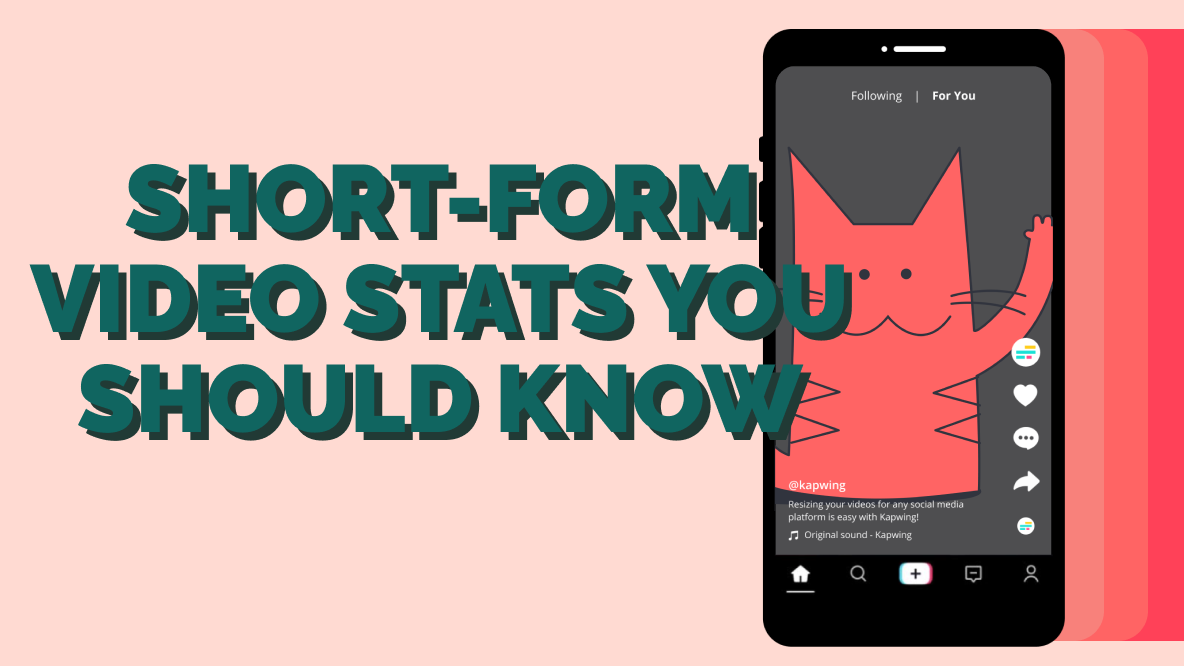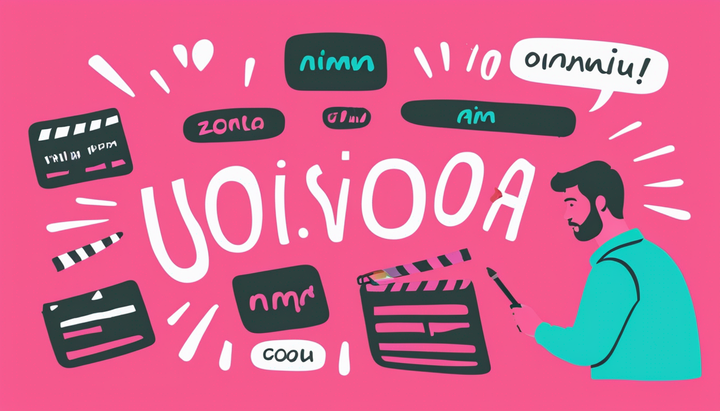Short-Form Video Statistics: Why Short-Form Matters (and Where It's Going Next)
We've rounded up the latest stats about short-form video, why it matters, and how to add it into your video marketing strategy.

If it feels like your attention span for online video has gotten shorter, it’s not just you.
Short-form video has taken over the internet and our phones. You could trace this phenomenon back to Vine, the now-defunct short-video app that introduced audiences to the joy of six-second looping short-form videos.
What Vine introduced to the masses, TikTok went on to perfect. TikTok is really the driving force that took short-form video from a fun meme format to a legitimate marketing pillar.
Short-form video is typically defined as anything under one-minute, although even videos of up to three minutes may be considered short-form. And while many platforms allow videos over a minute, the sweet spot for short-form videos is typically around 15 seconds.
Short-form videos are popular because they are:
- Digestible: Being under a minute, you can open up an app and quickly consume content.
- Entertaining: Short-form videos cover all kinds of topics, but the main theme is that they’re typically funny or entertaining.
- Scrollable: Short-form videos are presented in a never-ending feed, making it easy to get hooked in and scroll for hours.
Since TikTok’s meteoric rise, we’ve seen Instagram Reels and YouTube Shorts come about to compete in the vertical, short-form video space. Now, marketers have several platforms for sharing short-form video, and they’re definitely taking advantage.
Short-form videos have exploded as the hottest creative to invest in for marketers. According to HubSpot, 33% of social media marketers plan to invest in short-form videos in 2023, compared to only 11% who said the same about long videos.
Let’s dig into why short-form videos are absolutely worth the effort for marketers, with key short-form video statistics to back it up. We’ll also examine how short-form videos compare to long videos, and how we think short-form video content will change in the future. Finally, we’ll take a closer look at exactly how you can incorporate short-form videos into your marketing strategies.
Why marketers should invest in short-form videos
Whether you’re hoping to engage with your target audience or reach out to a whole new market, short-form videos are an ideal way to get the job done.
We know the statistics back that up. According to HubSpot’s State of Marketing 2023 report, marketers said short-form videos are the marketing trend with the highest return on investment. A third also said short videos are the trend that they intend to leverage in their marketing strategy. By all accounts, short-form video is the fastest-growing trend in marketing.
As well, 90% of marketers who use short-form videos plan to either maintain or increase their use in their marketing strategies in 2023.
Of all the options for short-form video platforms, TikTok endures as the most popular, with 42% of marketers already using it and 56% planning to increase their investment in TikTok in 2023. Also consider that the average TikTok user spends 46 minutes a day on the platform.
If you’re chasing virality, short-form videos are also the way to go. Again, according to HubSpot, 47% of video marketers agree that short-form videos are the most likely to go viral. Only 12% said the same about long videos.
Add that all together and you’ve got a compelling case for why marketers should be making short-form videos.
How short-form videos compare to long-form channels
Short-form video is red hot right now, and if we look at how its consumption differs from long-form video, we can see why.
First, short-form video is a mobile-first experience. Although TikToks, Instagram Reels, and YouTube Shorts can all be accessed from a desktop browser, they’re intended as a vertical, mobile experience, and that’s how most users watch them.
In the US, monthly TikTok users have now passed 100 million, which works out to just over 37% of the US’s mobile internet users. And according to Semrush, 84% of TikTok’s traffic comes from mobile devices.
Meanwhile, TV is becoming an increasingly popular viewing platform for long videos on YouTube, with over 120 million people watching from their TV every month.
Short-form is also inherently a more participatory experience. Long-form videos are often a one-way experience — you might have favorite YouTubers but have never posted a video yourself. Meanwhile, on TikTok, 83% of users have posted their own content, according to Wallaroo.
Short-form videos tend to skew towards a younger demographic. On TikTok, according to The Social Shepherd, nearly half of all users are under 29, and only 11% are over the age of 50. But on YouTube, 67% of those 56 years and older use the platform.
Overall though, online video is wildly popular for both forms. According to Statistica, 60% of YouTube users visit the site more than two times per day, and 54% of TikTok users visit TikTok twice or more on the daily.
How short-form video has changed (and how it will change)
When TikTok launched, video content could only be up to one minute in length, but that has changed. TikToks can now be up to three minutes long and for some users, even up to ten minutes.
As short-form video content evolves, users are blurring the lines between short-form and long-form content. While ultra-short videos will always be popular, statistics show that many accounts are posting longer content.
According to Statistica, the largest accounts on TikTok post videos with an average length of 41.9 seconds. Medium-sized accounts average 35.4 seconds and the smallest accounts average 32.4 seconds.
Don’t be mistaken though — these are just averages. A typical TikTok creator posts video content of varying lengths, some long, some short.
Another reason TikTok lengths are increasing is that creators have been incentivized to post longer content. In early 2023, the TikTok launched a beta of the Creativity Program. In order to be eligible for revenue under the program, creators mostly post TikToks that are at least one-minute long.
TikTok has also been keen to play around with its own limitations. In February 2023, Hilton Hotels and Paris Hilton posted a 10-minute long TikTok — a novel and massive length for the platform. It was posted organically, rather than as an ad, and reportedly saw 86 times more views than the average brand on the platform.
@hilton Unexpected & amazing things can happen when you stay, and we want you to stay with us for 10 minutes. Yup, we made a 10-minute TikTok AND we’re giving away 10M Hilton Honors Points + more. #HiltonStayFor10 #HiltonForTheStay ♬ Hilton’s 10-Minute Stay - Hilton
Another way creators have been pushing into long-form territory is with multi-part TikToks. This is a common method to boost engagement, because they leave a cliffhanger in each part, encouraging viewers to scroll to the next video. Perhaps the most talked-about iteration of this is when Paramount posted the entirety of the movie Mean Girls for one day in a 23-part series.
In the future, you can expect to see longer videos and multi-part series in organic content and video marketing alike. Similarly, don’t be surprised to see even shorter videos on platforms that are traditionally for longer videos, such as YouTube.
How to use short-form video in your video marketing strategy
By now you should be convinced that short-form video content is integral to any social media marketing strategy. But how do you put that into action?Let’s look at x ideas for how to use short-form video content.
1. Repurpose long-form content as short-form video
If you already have long-form video content on hand, then it can easily be flipped into short-form content.
You might already have different types of business video on hand, like webinars, ads, promotional content, behind the scenes footage, or documentaries. They all work.
First, look through your long-form video content and look for clips under one minute (or even under 15 seconds) that can stand on their own, such as:
- Insightful quotes
- A funny moment
- A product demonstration
- A piece of advice
- A how-to section
After you’ve found that great clip, you simply need to use some editing software to create social media videos. The most important things will be to resize the video to fit in a vertical format (1080×1920 for TikTok) and also add captions to the video as many people watch social videos on mute.
Another method is to use a video editor to turn a long-form clip into a shorter version, like a teaser or trailer. You can even use this to promote the longer piece of video content.
Once a video is edited into short-form, it can be shared to TikTok, Reals, and Shorts.
You can also repurpose content ideas as short-form video, even if the original asset doesn't lend itself well to a simple resize or reformatting. This is called content atomization, where you take one idea or theme and repurpose it for many assets across multiple channels.
2. Tap into social proof with UGC short-form video
The buzziest term for video marketers right now is UGC — user-generated content.
UGC is video content that is created organically by everyday people, but that may be of interest to brands. Think of someone reviewing a new mascara on TikTok, or someone showing how they prepare for a workout with a specific protein powder.
UGC plays well with audiences because it’s more authentic — the opinions expressed in this type of video content is genuine, rather than having been paid for by a brand.
A survey from Stackla found that consumer-generated content is viewed as the most authentic, with nearly 60% agreeing. By contrast, only about 10% said the same about traditional influencer content.
79% of people surveyed said UGC most impacts their purchasing decisions, compared to only 12% who said the same for brand-created content, and 9% who said the same for influencer-created content.
By using social listening, you can keep track of creators that are organically talking about your brand. Then, as part of your short-form social media marketing strategy, you can reach out to these creators and repost or license their content. You’ll find it's more effective at gaining engagement and converting customers than anything you make yourself.
There’s also UGC-style content, which is created by brands or professional UGC creators explicitly for the purpose of being used by a brand. This type of short-form video typically uses creators or actors who aren’t recognizable, as opposed to known influencers.
Here’s an example from Adobe. This ad was created to look like a creator organically sharing a photo editing tip, but is in fact a sponsored ad.
@danisorkphoto we’re living in the future, its fine 🤯 #adobegenerativefill #ai #photoshopai ♬ original sound - Dani Sork Photo
The trick to UGC is making sure it’s not overly-polished the way a brand-produced campaign would be. One popular format for UGC, for example, is a fake podcast setup. The people on screen look like they’re organically talking about a brand as part of a podcast, but it’s actually all a pre-scripted piece of content.
Whichever UGC method you use for short-form video, you’re bound to see great ROI.
3. Be experimental with your short-form video content
One of the joys of short form videos is there aren’t really any rules. They’re an opportunity to experiment and try out new formats and styles.
It’s recommended that you post to TikTok one to four times per day. Rather than letting that stress you out, take it as permission to quell any perfectionist tendencies.
Because short-form video is scrollable and flies by so fast, you can really get creative and take risks. The oddest things can turn viral or turn into memes on platforms like TikTok, but you won’t get there if you’re thinking too hard about every single second.
This is also important advice because we know that authenticity is the most important currency on TikTok. It’s better to earnestly try new things and have some fail then to stick to a script and consistently get mediocre engagement.
One of the best examples of this is language learning app Duolingo’s TikTok account. You could describe it as chaotic, but also hilarious and authentic. Some of their TikToks get millions of views, and some get far less. That’s a good thing — it shows they’re willing to throw everything at the wall and see what sticks. That should be your strategy, too.
If you need some inspiration, check out this list of YouTube Shorts ideas.
4. Move quickly and jump on short-form video trends
As a video marketer, you know that campaigns can often be slowed down by red tape or too many stakeholders. That just won’t fly when it comes to short-form video content.
Trends for short-form videos move at a lightning speed. And while they always trickle down to Instagram Reels and YouTube Shorts, these trends most often are born on TikTok.
New, viral memes and trends pop up on TikTok everyday. Some will only last for a day or so, while some can stretch out for a couple of weeks. Taking part in trends, whether it’s a trending song, a challenge, or just a funny thing to do, is a great way to gain engagement and appear in people’s For You pages.
The best way to keep up with trends is to be scrolling through TikTok, Instagram Reels, or YouTube Shorts yourself, or you can also reference the TikTok Creative Center. Because these trends are so short, you need to move quickly and join in as soon as possible.
If your short-form video content has to go through layers of approval or process that delays posting, you’ll be too late and look out of date and, frankly, pretty cringe. And cringe is the last thing you want to be on short-form video platforms.
Create a winning marketing strategy with short-form content
Short-form video content’s reign is here to stay, which means it must become an essential part of your social media marketing strategy.
The key to creating short-form video that resonates is to stick to the core tenets of authenticity, entertainment, and speed. Whether that emerges as UGC, cutting webinars into short-form videos, or a silly meme video, sticking to that advice will get you far.
We know from short-form video statistics that this medium is the preferred way for audiences — especially young audiences — to consume video content. If your target audience is Gen Z in particular, you really can’t go wrong with short videos.
The short-form video trend isn’t going anywhere, so hop on and see what you can create.
Create content faster with Kapwing's online video editor →








